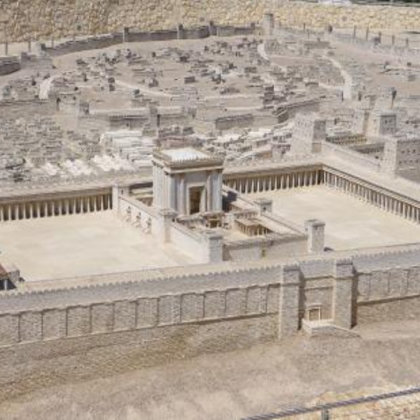HISTORY OF JERUSALEM,THE ROMAN DESTRUCTION AND REBUILDING OF JERUSALEM.AND KING HEROD THE GREAT (73 BCE ) WORKED WELL WITH ISRAEL'S ROMAN CONQUERORS.HE KNEW HOW TO GETS THINGS DONE BUT HE WAS , A BRUTAL MAN WHO KILLED HIS FATHER IN LAW.
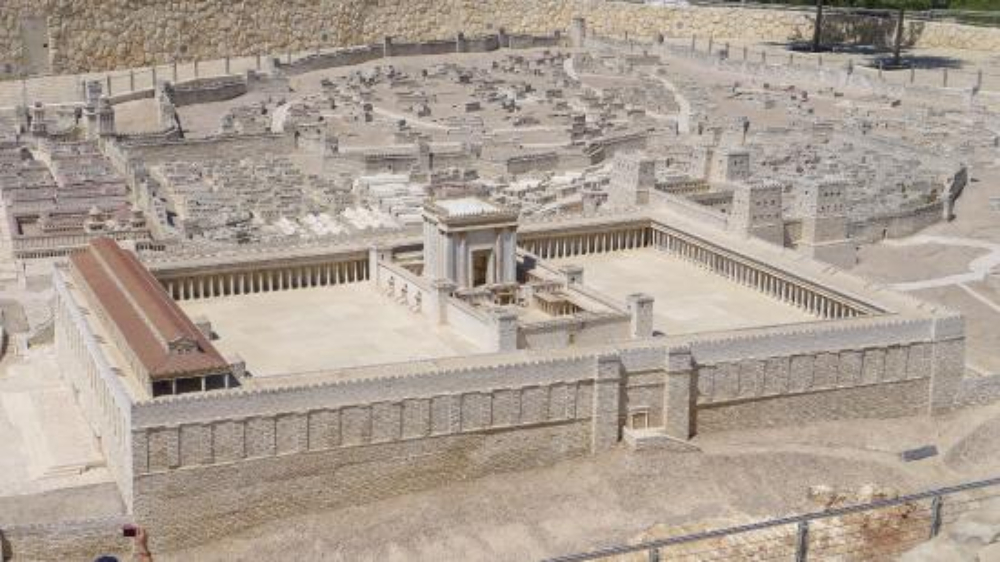
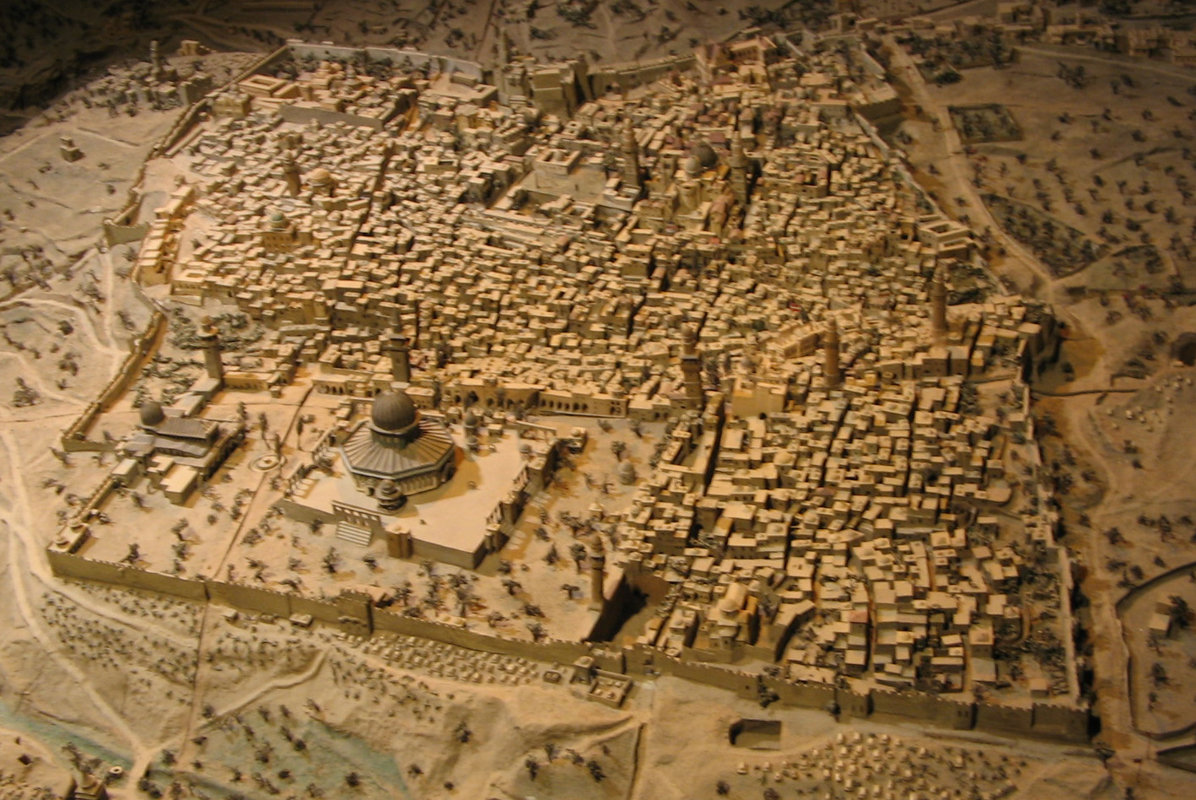 Although the Temple is referred to as a single institution here, it is important to note that the Jerusalem Temple was rebuilt at least three times in antiquity. The first was erected under Solomon, as is described in great detail within 1 Kings 5-6, approximately during the 10th century BCE. The second was built by returning exiles in approximately 515 BCE, while the third, and most elaborate, was developed under Herod in approximately 19-9 BCE, although it remained under renovations until its destruction in 70 CE. Generally, the Temple established by the returning exiles and Herod’s Temple are conflated in scholarship and referred to as simply, the 'Second Temple', or the 'Second Temple period'. Although the physical characteristics described will refer to Second Temple evidence, the term 'Temple' here will represent all three as it is the general establishment of the institution that is of interest rather than the architectural differences between all three.
Although the Temple is referred to as a single institution here, it is important to note that the Jerusalem Temple was rebuilt at least three times in antiquity. The first was erected under Solomon, as is described in great detail within 1 Kings 5-6, approximately during the 10th century BCE. The second was built by returning exiles in approximately 515 BCE, while the third, and most elaborate, was developed under Herod in approximately 19-9 BCE, although it remained under renovations until its destruction in 70 CE. Generally, the Temple established by the returning exiles and Herod’s Temple are conflated in scholarship and referred to as simply, the 'Second Temple', or the 'Second Temple period'. Although the physical characteristics described will refer to Second Temple evidence, the term 'Temple' here will represent all three as it is the general establishment of the institution that is of interest rather than the architectural differences between all three.
The common believe was that Ancient Jerusalem was situated within what is today called the Old City 150 years ago . The walls of the Old City however were built by Sultan Suleiman the Great about 450 years ago. Parts of the extended First Temple period Jerusalem in the times of Hezekiah as well as a great deal of the Second Temple period lies within the Old City Walls. When David conquered the Jebusite city, Jebus, the Bible says he called it the City of David.When he refers to the city in his Psalms however, he calls it Jerusalem, as it is generally referred to in the Bible. The whole First Temple period in the times of David and Solomon, is situated on this hill South of Temple Mount, and except for Temple Mount where the Temple stood, the origins of Zion lies outside the walls of the Old City. All the current excavations are done according to the highest standards by the Israel Antiquities Authority. City of David.Ancient Jerusalem sat centrally located within the mountains of western Palestine. It was a city of hills and valleys. At an elevation of 2,600 feet, Jerusalem belongs to a stretch of mountains known as the Central Mountain Range, or Central Ridge.Jerusalem sits nestled amongst the hills of Judea, a stretch of hills ranging over 60 miles from Bethel in the north to Beersheba in the south. Bethel, the Mount of Olives near Jerusalem and the mountains of Bethlehem are all part of the same range. The hill country of Ephraim also incorporated some of this region.Steep ravines descending to the valleys below provided natural support to Jerusalem in the west, south and east. Though not located on any international trade routes of antiquity, Jerusalem was a strategic city in a strategic location. People were first attracted to the Gihon Spring. It is a natural spring and the only steady and reliable water source in Jerusalem, and one of the very few in all of the central mountain region.The Central Ridge is also the watershed. To the east of Zion wadis plummet into the Jordan Valley on their way to the Jordan River and the Dead Sea. To the west, water descends into the Shephelah and the many western flowing streams ending up in the Great Sea. Throughout Jerusalem's history the terrain has protected it in many instances, yet the city has its vulnerabilities, particularly in the north.Elevation in the region ranges from 2,000 feet to 3,300 feet above the Mediterranean Sea. Bethel was 2,900 feet above the sea, and ten miles north of Jerusalem. The higher elevations were in the south near Hebron. Jerusalem was nestled into these mountains surrounding her.To the south and southeast of the city of God was a vast and formidable wilderness. The wilderness of Judea included the wildernesses of Zaphon and Maon, which lay further to the south of Hebron and made famous through the exploits of David and Saul. In the east, the Dead Sea. The city of Jerusalem and the nation of Israel became intertwined under King David. He conquered Jebus from the Jebusites, renaming his new capital Jerusalem. King David forever tied together Jerusalem and Israel.The core of Jerusalem, Old City, has a history that stretches back more than 3,000 years. The present street plan dates largely from Byzantine times, with the walls and ramparts dating back to the 16th century. The crossroad of three continents, Jerusalem has been one of the most fought over cities in human history. Within the walls, the Old City is divided into four vaguely defined quarters: Christian, Armenian, Jewish and Muslim.Anyone with a sense of history, spirituality or the human species should be absorbed by the tremendous weight of human civilization that cloaks nearly every part of the city. It is an inhabited, living city not a deserted museum or monument. Humanity's passion play has been constant revival at this location for most of the length of recorded history.As a legacy of Rome's occupation of Jerusalem, a Cardo (market street) still today runs north-to-south down the center of the city; this road has been excavated and re-opened with modern shops among the ancient columns today, about two stories underground in an open-air strip of the city. The Old City is also bisected by an east-to-west road (known as a Roman "decumano"), thus forming four "quarters". And so today it still has four distinct districts , representing the major religions who have occupied the Old City.The Christian Quarter is the northwest quarter. It contains the Holy Sepulchre, and shares the Damascus Gate (north side of City) with the Muslim Quarter and the Yafo Gate (west side of city) with the Armenian Quarter. Just outside its walls are the Mamilla Pool and a Herodian Cistern; in this region of the world, water is and always was vital for the city. Presently, Mamilla has some of Israel's most expensive shopping and housing, and many nearby churches also are just outside of the Christian Quarter.The Armenian Quarter is also Christian, but distinctly Eastern Christianity; it is in the southwest corner of the Old City. An Armenian alliance with Jews dates back to Israel's Hellenistic Era, but Jerusalem isn't attested to have an area called an Armenian "quarter" until near The Crusades. It is the smallest quarter, but contains the Zion Gate, and south of this gate is the historic Mount Zion (outside the walls, but quite well protected by steep slopes on all other sides). The Armenian Quarter contains the Tower of David, a late First Temple era fortification, and an Armenian Orthodox cathedral, monastery, and museum, as well as smaller holy sites for all three major religions. The City Walls contained what is now the Armenian Quarter by 586 BCE, and Herodian Jews began to build the Sultan's Pool (Ottoman Turks later expanded it) west of the Armenian Quarter by damming the Himmon Valley which runs north-to-south, forming a natural moat just west of The Armenian Quarter, then the Hinnom Valley turns east and runs along the southern City Wall. Aqueducts from as far as the cities of Bethlehem and Beytan fed this southwestern pool.The Jewish Quarter in the southeast of the Old City includes some relics dating from the First Temple era; their foundations are up to 75' (25m) below the current ground-elevation. Tanner's Gate and Dung Gate lead south from the Jewish Quarter to the City of David which pre-dates the Old City and was called the "Lower City" since the late-Israelite era. To the southeast is the city's earliest known water source, Gihon Spring, which brought water uphill (under natural pressure) into the fortified walls of The Lower City, then later into the Old City, via a well-hidden and formerly guarded tunnel (which is typical of many Israelite and other Canaanite cities). To the east of the Jewish Quarter is the Mount of Olives, notable for its 3000 year-old Jewish burial ground and several Christian churches, where the New Testament says Jesus often made sermons.The Muslim Quarter is in the northeast of the Old City and is where most of the city's mosques are; Muslims also meet atop the Mount, and weekly at the wall east of the Temple Mount. Despite its name, there are several Christian landmarks such as Ecce Homo and half of the Via Dolorosa in The Muslim Quater, and it is Old City's largest quarter. It has been within Jerusalem's City Walls only since circa 20 CE, the Romanized-Jewish (Herodian) era, and the area next to Damascus Gate contains a giant 100,000sq-ft cave that was used to quarry stones since at least the Second Temple era (after 530 BCE). Also within the Muslim Quarter are The Bethesda Pools, built between 800 and 200 BCE. Lion's Gate and Damascus Gate are the largest entries for those entering from the new State of Palestine and from the historic Mount of Olives which is a ridge that runs north-to-south along the Old City's eastern wall, but the Kidron Valley is between the Mount of Olives and the eastern City Wall.The Kidron and Hinnom Valleys meet southeast of the city near Gihon Spring, thus forming a natural defensive line on the west, south, and east sides of Jerusalem, but today the western side is filled in by millennia of debris.The Jewish Quarter traditionally included the Temple Mount, however only Muslims are allowed inside the Dome of the Rock at the center of the Mount, non-Muslims still may ascend the outdoors areas of the Temple Mount, and the 1990's Oslo Accords preserve this access indefinitely. For political reasons, it is not considered part of the Muslim Quarter nor the Jewish Quarter today. The main entry to the mount for non-Moslems is at the south end of The Western Wall; and there are many entrances from the Muslim Quarter. A cistern and many tunnels are under the Temple Mount: some are ancient, some medieval, and some are still being created to expose areas that were originally exposed but have since been filled in. None of the walls of The Temple Mount are built into, nor integral or shared with, the City Wall; it is about 25m (75') or more from the nearest City Wall, and just as tall. The Temple Mount is more than 275m x 470m, thus a perimeter longer than 7/8 of a mile, and the City Walls are of course even longer.
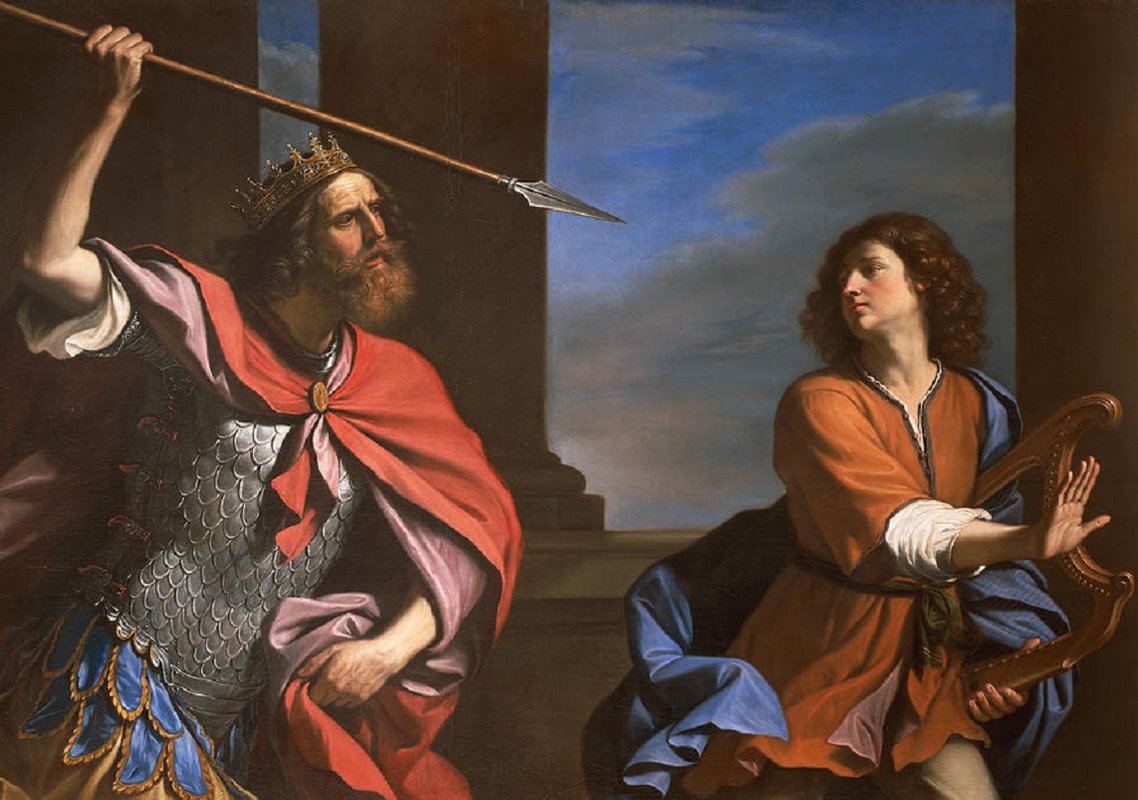 Battle around Jerusalem.King David is one of the most important figures in Jewish history. Born in 907 BCE, he reigns as king of Israel for 40 years, dying at age 70 in 837 BCE.The hereditary bloodline of King David will become the only legitimate royal bloodline in Jewish history. From David will come all the future kings of Judah and ultimately, at the end of history, the Messiah.When David takes the throne, Egypt and Assyria are both on a significant decline. They're not in any position to expand, which leaves a vacuum in the middle where Israel is located, and Israel is allowed to expand unmolested by these other great empires.
Battle around Jerusalem.King David is one of the most important figures in Jewish history. Born in 907 BCE, he reigns as king of Israel for 40 years, dying at age 70 in 837 BCE.The hereditary bloodline of King David will become the only legitimate royal bloodline in Jewish history. From David will come all the future kings of Judah and ultimately, at the end of history, the Messiah.When David takes the throne, Egypt and Assyria are both on a significant decline. They're not in any position to expand, which leaves a vacuum in the middle where Israel is located, and Israel is allowed to expand unmolested by these other great empires.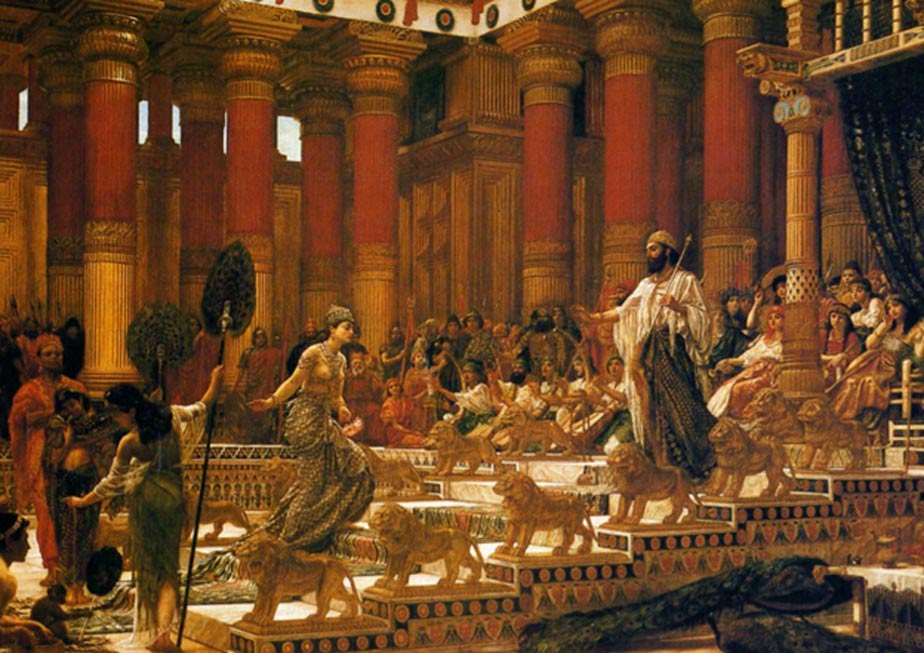 King Solomon was the wisest man who ever lived and also one of the most foolish. God gifted him with unsurpassed wisdom, which Solomon squandered by disobeying God's commandments.Solomon was the second son of King David and Bathsheba. His name means "peaceable." His alternative name was Jedidiah, meaning "beloved of the Lord." Even as a bab.A conspiracy by Solomon's half-brother Adonijah tried to rob Solomon of the throne.To take the kingship, Solomon had to kill Adonijah and Joab, David's general.
King Solomon was the wisest man who ever lived and also one of the most foolish. God gifted him with unsurpassed wisdom, which Solomon squandered by disobeying God's commandments.Solomon was the second son of King David and Bathsheba. His name means "peaceable." His alternative name was Jedidiah, meaning "beloved of the Lord." Even as a bab.A conspiracy by Solomon's half-brother Adonijah tried to rob Solomon of the throne.To take the kingship, Solomon had to kill Adonijah and Joab, David's general.
King Herod The Great .
Herod was born 73 BCE as the son of a man from Idumea named Antipater and a woman named Cyprus, the daughter of an Arab sheik. Antipater was an adherent of Hyrcanus, one of two princes who struggling to become king of Judaea.In this conflict, the Roman general Pompey intervened in Hyrcanus' favor. Herod's reign ended in terror. When the king fell ill, two popular teachers, Judas and Matthias, incited their pupils to remove the golden eagle from the entrance of the Temple: after all, according to the Ten Commandments, it was a sin to make idols. The teachers and the pupils were burned alive. Some Jewish scholars had discovered that seventy-six generations had passed since the Creation, and there was a well-known prophecy that the Messiah was to deliver Israel from its foreign rulers in the seventy-seventh generation .The story about the slaughter of infants of Bethlehem in the second chapter of the Gospel of Matthew is not known from other sources, but it would have been totally in character for the later Herod to commit such an act.A horrible disease probably a cancer-like affection called Fournier's gangrene made acute the problem of Herod's succession, and the result was factional strife in his family. Shortly before his death, Herod decided against his sons Aristobulus and Antipater, who were executed in 7 and 4 BCE, causing the emperor Augustus to joke that it was preferable to be Herod's pig hus than his son huios - a very insulting remark to any Jew.However, the emperor confirmed Herod's last will. After his death in 4 BCE, the kingdom was divided among his sons. Herod Antipas was to rule Galilee and the east bank of the Jordan as a tetrarch; Philip was to be tetrarch of the Golan heights in the north-east; and Archelaus became the ethnarch ("national leader") of Samaria and Judaea. Herod was buried in one of the fortresses he had built, Herodion. Few will have wept.Having favored the winning side in the conflict, Antipater's star rose, especially since he cooperated with the Romans as much as possible. In the civil war between Pompey and Julius Caesar, Hyrcanus and Antipater sided with the latter, for which especially the courtier was rewarded: in 47, he was appointed epitropos and received the Roman citizenship.It was obvious that Antipater was the real power behind Hyrcanus' throne. He managed to secure the appointment of his son Herod to the important task of governor of Galilee. He launched a small crusade against bandits, which made him very popular with the populace and impopular with the Sanhedrin.On March 15, 44 BCE, Caesar was murdered. The new leaders in Rome were Caesar's nephew Octavian and Caesar's powerful second-in-command Mark Antony. They announced that they would punish Caesar's murderers, Brutus and Cassius, who fled to the East. Cassius ordered all provinces and principalities to pay money for their struggle against Octavian and Mark Antony, and Judaea had to pay some 15,000 kg of silver. Antipater and his sons had to take harsh measures to get the money, and in the ensuing troubles, Antipater was killed. With Roman help, Herod killed his father's murderer.In 43, Hyrcanus' nephew Antigonus tried to obtain the throne. Herod defeated him, and secured the continuity of the line of Hyrcanus by marrying his daughter Mariamme. Of course, the young man was not blind to the fact that this marriage greatly enhanced his own claim to the throne.Meanwhile, Octavian and Mark Antony had defeated Brutus and Cassius . Herod managed to convince Mark Antony, who made a tour through the eastern provinces that had supported Caesar's murderers, that his father had been forced to support their side. The Roman leader was convinced, and awarded Herod with the title of tetrarch of Galilee, a title that was commonly used for the leaders of parts of vassal kingdoms. (Herod's brother Phasael was to be tetrarch of Jerusalem; Hyrcanus remained the Jewish national leader in name only.This appointment caused a lot of resentment among the Jews. After all, Herod was not a Jew. He was the son of a man from Idumea; and although Antipater had been a pious man who had worshipped the Jewish God sincerely, the Jews had always looked down upon the Idumeans as racially impure. Worse, Herod had an Arab mother, and it was commonly held that one could only be a Jew when one was born from a Jewish mother. When war broke out between the Romans and the Parthians (in Iran and Mesopotamia), the Jewish populace joined the latter. In 40, Hyrcanus was taken prisoner and brought to the Parthian capital Babylon; Antigonus became king in his place; Phasael committed suicide.Herod managed to escape and went to Rome, where he persuaded Octavian and the Senate to order Mark Antony to restore him. And so it happened. After Mark Antony and his lieutenants had driven away the Parthians, Herod was brought back to Jerusalem by two legions, VI Ferrata whose men had already fought in Gaul and the civil wars and another legion, perhaps III Gallica (37 BCE). Antigonus was defeated and after he had besieged and captured Jerusalem, and had defeated the last opp, Herod could start his reign as sole ruler of Judaea. He assumed the title of basileus, the highest possible title.Herod's monarchy was based on foreign weapons, the start of his reign had been marked by bloodshed. His first aim was to establish his rule on a more solid base. Almost immediately, he sent envoys to the Parthian king to get Hyrcanus back from Babylon. The Parthian king was happy to let the old man go, because he was becoming dangerously popular among the Jews living in Babylonia. Although Hyrcanus was unfit to become high priest again, Herod kept his father-in-law in high esteem. The support of the old monarch gave an appearance of legality to his own rule.The new king started an extensive building program: Jews could take pride in the new walls of Jerusalem and the citadel which guarded its Temple. (This fortress was called Antonia, in order to please Herod's patron Mark Antony.Coins were minted in his own name and showed an incense burner on a tripod, intended to signify Herod's care for the orthodox Jewish cult practices. These coins had a Greek legend - HÈRÔDOU BASILEÔS - which indicates that Herod considered his standing abroad. And the new king continued to please the Romans, to make sure that they would continue their support. He sent lavish presents to their representative in the East, Mark Antony, and to his mistress, the Egyptian queen Cleopatra.These gifts almost were Herod's undoing. The relations between on the one hand Mark Antony and Cleopatra in the East and on the other hand Octavian and the Senate in the West became strained, and civil war broke out in 31. It did not last very long: in August, the western leader defeated the eastern leader, who fled to Alexandria. For the first time in his life, Herod had aligned himself with a loser.He managed to solve this problem, however. First, he had Hyrcanus executed, making sure that no one else could claim his throne. Then, he sailed to the island of Rhodes, where he met Octavian. In a brilliant speech, Herod boasted of his loyalty to Mark Antony, and promised the same to the new master of the Roman Empire. Octavian was impressed by the man's audacity, confirmed Herod's monarchy, and even added the coast of Judaea and Samaria to his realm. Actually, Octavian did not have much choice: his opponents were still alive, and if he were to pursue them to Egypt, Herod could be a useful ally. As it turned out, Mark Antony and Cleopatra preferred death to surrender, and Octavian became the only ruler in the Roman world. Under the name Augustus, he became the first emperor. He rewarded his ally with new possessions: a.o. Jericho and Gaza, which had been independent.Herod's position was still insecure. He continued his building policy to win the hearts of his subjects. A severe earthquake in 31 BCE had destroyed many houses, killing thousands of people.In Jerusalem, the king built a new market, an amphitheater, a theater, a new building where the Sanhedrin could convene, a new royal palace, and last but not least, in 20 BCE he started to rebuild the Temple. And there were other cities where he ordered new buildings to be placed: Jericho and Samaria are examples. New fortresses served the security of both the Jews and their king: Herodion, Machaerus, and Masada are among them.But Herod's crowning achievement was a splendid new port, called Caesarea in honor of the emperor (the harbor was called Sebastos, the Greek translation of "Augustus"). This magnificent and opulent city, which was dedicated in 9 BCE, was built to rival Alexandria in the land trade to Arabia, from where spices, perfume and incense were imported. It was not an oriental town like Jerusalem; it was laid out on a Greek grid plan, with a market, an aqueduct, government offices, baths, villas, a circus, and pagan temples. The most important of these was the temple where the emperor was worshipped; it commanded the port.) The port was a masterpiece of engineering: its piers were made from hydraulic concrete which hardens underwater) and protected by unique wave-breaking structures.Although Herod was a dependent client-king, he had a foreign policy of his own. He had already defeated the Arabs from Petra in 31, and repeated this in 9 BCE. The Romans did not like this independent behavior, but on the whole, they seem to have been very content with their king of Judaea. After all, he sent auxiliaries when they decided to send an army to the mysterious incense country (modern Yemen; 25 BCE). In 23, Iturea and the Golan heights were added to Herod's realms, and in 20 several other districts.With building projects, the expansion of his territories, the establishment of a sound bureaucracy, and the development of economic resources, he did much for his country, at least on a material level. The standing of his country -foreign and at home- was certainly enhanced. However, many of his projects won him the bitter hatred of the orthodox Jews, who disliked Herod's Greek taste - a taste he showed not only in his building projects, but also in several transgressions of the Mosaic Law.The orthodox were not to only ones who came to hate the new king. The Sadducees hated him because he had terminated the rule of the old royal house to which many of them were related; their own influence in the Sanhedrin was curtailed. The Pharisees despised any ruler who despised the Law. And probably all his subjects resented his excessive taxation. According to Flavius Josephus, there were two taxes in kind at annual rates equivalent to 10.7% and 8.6%, which is extremely high in any preindustrial society.note It comes as no surprise that Herod sometimes had to revert to violence, employing mercenaries and a secret police to enforce order.On moments like that, it was clear to anyone that Herod was not a Jewish but a Roman king. He had become the ruler of the Jews with Roman help and he boasted to be philokaisar "the emperor's friend", entertaining Agrippa, Augustus' right-hand man. On top of the gate of the new Temple, a golden eagle was erected, a symbol of Roman power in the heart of the holy city resented by all pious believers. Worse, Augustus ordered and paid the priests of the Temple to sacrifice twice a day on behalf of himself, the Roman senate and people. The Jewish populace started to believe rumors that their pagan ruler had violated Jewish tombs, stealing golden objects from the tomb of David and Solomon.
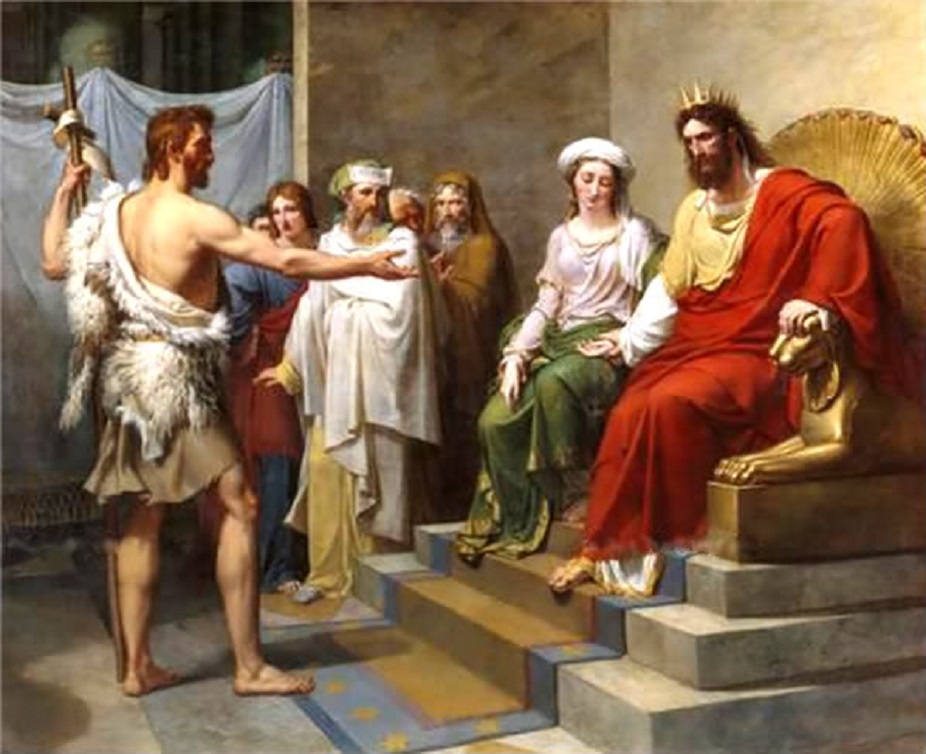 King Herod the Great,He was a brutal man who killed his father-in-law, several of his ten wives, and two of his sons. He ignored the laws of God to suit himself and chose the favor of Rome over his own people. Herod's heavy taxes to pay for lavish projects forced an unfair burden on the Jewish citizens.
King Herod the Great,He was a brutal man who killed his father-in-law, several of his ten wives, and two of his sons. He ignored the laws of God to suit himself and chose the favor of Rome over his own people. Herod's heavy taxes to pay for lavish projects forced an unfair burden on the Jewish citizens.Theater - King Herod's reign during the Second Temple period was mostly peaceful and characterized by economic prosperity and a building boom. Herod ruled Jerusalem for thirty-three years (37 BC – 4 AD ), during which he continuously balanced his loyalty to Rome with his commitment and obligations to his Jewish subjects. He turned Jerusalem into a Hellenistic city, including all the constituent elements and institutions of a Polis. He built a large theatre, instituted wrestling tournaments in honor of the Emperor and staged spectacles where men fought wild animals.
The Roman Destruction and Rebuilding of Jerusalem.
For the city of Jerusalem, the First Judean Revolt against Rome culminated in the capture and demolition of the city in 70 AD by general and future emperor Titus Flavius.In Jerusalem, the temple captain signified solidarity with the revolt by stopping the daily sacrifices to Caesar. Soon all Jerusalem was in an uproar, expelling or killing the Roman troops. Then all Judea was in revolt; then Galilee.Cestius Callus, the Roman governor of the region, marched from Syria with twenty thousand soldiers. He besieged Jerusalem for six months, yet failed. He left six thousand dead Roman soldiers, not to mention weaponry that the Jewish defenders picked up and used.Emperor Nero then sent Vespasian, a decorated general, to quell the Judean rebellion. Vespasian put down the opposition in Galilee, then in Transjordan, then in Idumea. He circled in on Jerusalem. But before the coup de grace, Nero died. Vespasian became embroiled in a leadership struggle that concluded with the eastern armies calling for him to be emperor. One of his first imperial acts was to appoint his son Titus to conduct the Jewish War.This was followed by the eventual rebuilding and renaming of the city as Aelia Capitolina by Emperor Hadrian in 130 AD, then a violent response to Romanization of the city by the Bar Kokhba Revolt which lasted from 132-136 AD. In the space of several decades, not only had the city of Jerusalem and the Temple suffered obliteration, but the entire region had been desolated by wars, and the Romans even attempted to erase the memory of the city, the land, and events that had occurred there.Not long after the Triumphal Entry in 33 AD, Jesus predicted the destruction of the Temple in Jerusalem, even specifying that not one stone would be left upon another which would not be torn down (Matthew 24:1-2; Mark 13:1-2; Luke 21:5-6). According to multiple historical sources, the Temple was reduced to rubble in 70 AD when the Romans finally breached the city walls after a siege of a few months and destroyed the city, including the entire Temple complex. While the Gospels emphasize the obliteration of the Temple, Jesus also predicted the siege and destruction of the city (Luke 19:41-44, 21:20-24). In these predictions, Jesus specified that armies would surround the city, besiege it, destroy it, that the people of Jerusalem would be killed and led captive, and that Jerusalem would be tread upon by the nations. After more than three years of fighting in Judea, the Romans under the leadership of general Titus Flavius finally surrounded Jerusalem with four legions. However, remembering the predictions of Jesus, Christians in Jerusalem fled the city and surrounding area, with most temporarily relocating to Pella during the war . Jerusalem was a city of magnificent defenses, with walls added in phases as the population expanded, and by 44 AD it had three massive walls. The Romans were able to easily breach the two outside walls, but despite infighting the defenders held out behind the last wall for a few months (Tacitus, Histories). Eventually, however, the Romans took the Antonia Fortress and then burned the Temple, which was supposedly accidental. According to Josephus, general Titus had sought to spare the Temple but convert it into a pagan place of worship (Josephus, Wars). About four weeks later, the final holdouts in the upper city had been defeated, and the ruins of Jerusalem were in total Roman control. Archaeological excavations throughout the city have shown the extent to which the city was destroyed and the Temple was annihilated. In fact, the only remains of the Temple seemed to be loose stones and broken pieces of the building pushed off of the side of the mount or littered around the platform, indicating a total demolition of the Temple, just as Jesus had predicted 37 years earlier. Josephus noted that Jerusalem “was so thoroughly laid even with the ground by those that dug it up to the foundation, that there was left nothing to make those that came thither believe Jerusalem had ever been inhabited” (Josephus, Wars). Corinthian capitals were discovered among the ruins on the Jerusalem Temple Mount, as this was the most popular style in the Roman Empire and a favorite of Herod the Great. During his reign, Herod had remodeled and expanded the entire Temple complex, including building a stoa or portico around the complex which used these capitals, but every building on the Temple Mount had been burned and torn down by the Romans (John 10:23). Toppled blocks from the ruins of the Jerusalem Temple complex were also found on the 1st century street below and to the west. In the rubble a stone from one of the towers at the corner of the Temple Mount was found, inscribed in Hebrew and reading “to the place of the trumpeting.” Looted treasures were carried off to Rome as victory plunder, displayed on the Arch of Titus in Rome, including the gold menorah (lampstand). During the fighting, thousands among the defenders of Jerusalem were killed, and after the capture of the city, thousands more became slaves and were spread around the Empire, or if able to escape, fled the region (Josephus, Wars). It has been estimated that about one third of the population of Judaea Province was killed or enslaved as a result of the revolt. The sects of the Essenes and the Sadducees disappeared, but the synagogue and the Pharisees rose to even greater prominence, becoming the future of Judaism. The prophesies that Jesus made—a siege and destruction of Jerusalem by armies surrounding the city, the total annihilation of the temple, the death of many in battle, the fleeing of others, the enslavement and scattering into different parts of the world, and the trampling of Jerusalem by the nations had been fulfilled. Once fighting had ceased, general Titus departed for Rome but left Legion X Fretensis stationed at Jerusalem to defeat any remaining resistance in Judea and keep the area under Roman control. According to a 3rd century source, the conquering general Titus supposedly refused the victory wreath because he thought there was no merit in vanquishing a people forsaken by their own God One of the results of this war was a two drachma tax called the Fiscus Judaicus, instituted by Emperor Vespasian, father of general Titus Flavius, which all practitioners of Judaism throughout the Roman Empire were supposed to pay yearly as a contribution to the Temple of Capitoline Jupiter in Rome (Josephus, Wars; Suetonius, The Twelve Caesars; Cassius Dio, Roman History). This tax was meant to replace the Jerusalem Temple tax, and was a punishment for rebellion against Rome. However, anyone who abandoned Judaism became exempt from paying the tax. Following the destruction of Jerusalem in 70 AD, much of the city lay dormant and unoccupied except for Roman camps of the 10th Legion. The city had so thoroughly been destroyed and then left unoccupied that many of the architectural remains, such as basements of buildings, were left in place and simply built over. Stationed in the ruins of Jerusalem, primarily on the west side of the city, the 10th Legion settled into a military camp after the conquest of the city. Legio X Fretensis, or the 10th Legion of the Strait, was founded by Augustus around 40 BC during the Roman civil war that eventually resulted in the formation of the Empire. The legion was designated 10th in honor of the famous legion of Julius Caesar, and named Fretensis due to its involvement in the battle at the Strait of Messina. Many tiles stamped with the name and number of the legion, and its icons such as the bull, boar, ship, or Neptune have been found where Legion X camped in Jerusalem in the 1st and 2nd centuries. Soldiers remained stationed there the next 62 years when the Bar Kokhba Revolt broke out, as also evidenced by a supply account for soldiers in Judea dated to 128. Soon after 70 AD, Christians returned to Jerusalem, and apparently resumed meeting at the “Church of the Apostles” on Mount Zion, near the Roman military camp.However, after almost 60 years of peace in Judaea Province, a major rebellion surfaced again. The Bar Kokhba revolt seems to have been inflamed by the plans of Emperor Hadrian to include Roman temples in the rebuilding of Jerusalem, and particularly upon the site of the Temple of Yahweh, which was revealed when he visited the city around 130 AD. Originally, Hadrian had intended to rebuilt the Temple of Yahweh, but later deciding that it may foster rebellion against Rome, he opted for an alternative construction project. This plan in particular, the attempt to build a temple to Jupiter where the Temple of Yahweh had been, was probably the catalyst for the uprising (Cassius Dio, Roman History). Bar Kokhba, a false messiah claimant, enlisted as many people as possible to fight a guerilla war against the Romans. Yet, the reasons for Hadrian coming to Jerusalem and rebuilding the city seem to be connected with his mission to defeat Christianity rather than aggravating Judaism or removing the association of Israel and Judah with the renamed land. Earlier in his reign, Hadrian had begun to devise plans to eradicate Christianity from the Roman Empire due to its beliefs and worldview that were completely opposite to the pagan Roman way of thinking, and its rapid spread across the Empire in all social classes over the last several decades. Being a scholar and philosopher in the Greek tradition, Hadrian believed that Christianity could be more effectively eliminated through ideological policies rather than executions. In Athens, around 124 AD, the Emperor held discussions and “negotiations” with Christians, including two scholars named Aristides and Quadratus, hoping to defeat Christianity intellectually and syncretizing the worship of Christ into the Roman pantheon, apparently even offering to place a statue of Christ in Rome (Golan, “Hadrian’s Decision to Supplant Jerusalem by Aelia Capitolina”). However, the Christians rejected this offer of syncretism and modification of Christianity into a part of the Roman religious system. The failure seems to have spurred Hadrian to attempt another strategy, involving the paganization of sites related to Jesus and Christianity. Knowing that Jerusalem had been central to Jesus and Christianity, Hadrian went to the city with this new plan. Rebuilding Jerusalem and founding it as a Roman colony in place of the ruins, Hadrian renamed the city Aelia Capitolina in honor of his family name and the god Jupiter. The province was expanded and renamed Syria Palaestina, supplanting Israel with Philistia. While this act certainly erased historical associations, it also directly challenged Jesus and Christianity by making the very name of the city into a Roman deity and Emperor, attempting to show the supremacy of Rome, its gods, and its Emperor. The city was reconstructed according to typical Roman plan, with a north-south cardo and an east-west decumanus, although many scholars suggest that there were two of each of these main north-south and east-west streets due to the odd topography of the city. The Roman forum was at the center, and this is where the temple of Jupiter ended up being built, alongside a sanctuary to Venus and over the tomb of Jesus (Eusebius, Life of Constantine; Jerome, Letter to Paulinus). Other sites in the area which had an association with Jesus which Hadrian had pagan temples and shrines built over include the birthplace of Jesus in Bethlehem, the Pool of Bethesda, and the Pool of Siloam. The originally planned site for the temple of Jupiter, on the Temple Mount and former site of the temple of Yahweh, remained desolate except for a statue of Emperor Hadrian riding a horse. The next Emperor, Antonius Pius, also placed a statue of himself riding a horse on the Temple Mount, and the inscription from the pedestal of this statue can be seen today in a rebuilt section of the southern wall of the Temple Mount. In the 4th century, the Bordeaux Pilgrim noted two Emperor statues, although he mistakenly thought that both statues were of Hadrian, as they probably looked extremely similar. The walls of Jerusalem were not rebuilt at this time, which was typical for the Roman Empire as they were both unnecessary for defense against foreign enemies because of the legions, and prevented local rebels from forcing the Romans to besiege cities. The 10th Legion continued to inhabit the city, as evidenced by discoveries such as a ca. 130 AD Latin inscription found in Jerusalem, dedicated by Legion X Fretensis to Emperor Hadrian. In Aelia Capitolina around this time, the Emperor also had coins issued to commemorate the founding of the colony and the building of the main temple. One coin showed an image of Jerusalem being ritually plowed for the new founding, while another coin showed the temple of Jupiter.Soon after Hadrian left the area, full scale revolt began, and the temple of Jupiter on the Temple Mount was not completed. This revolt further depopulated Judea, with tens of thousands slain and many cities and towns ruined. Cassius Dio even remarked that wolves and hyenas howled in the cities . Jerusalem itself was apparently besieged again during the reign of Hadrian, perhaps due to a contingent of rebels temporarily taking control of the city . Roman coins overstruck by the rebels with Hebrew inscriptions and religious iconography such as the temple façade have been found throughout the area, including in Jerusalem, suggesting that the city was occupied by Bar Kokhba and his followers for an unknown amount of time until the Romans besieged the city and took back control . Christians did not support either of the revolts in Judea, and Eusebius recorded that many Christians suffered torture and death when they refused to join the Bar Kokhba revolt and attack Roman soldiers. After over three years of fighting (132-136 AD), the Romans subdued the rebels and their false messiah Simon Bar Kokhba, who was executed along with other leaders of the rebellion. The effect of the rebellion was devastating to Judaism and the entire land of Judea, including the erasure of the ancient names and associations with Israel and Judah, the banning of the Mosaic Law, and the execution of many leaders of Judaism. For Jerusalem in particular, Hadrian completely banned Judaism in the city and barred Judeans from entering Jerusalem except once a year on Tisha B’Av (9th of the month Av), the day commemorating the destruction of the Temple in 70 AD. From the time of Hadrian, the city remained a place of both pagan and Christian worship until radical changes began in the 4th century after the legalization of Christianity by Emperor Constantine.
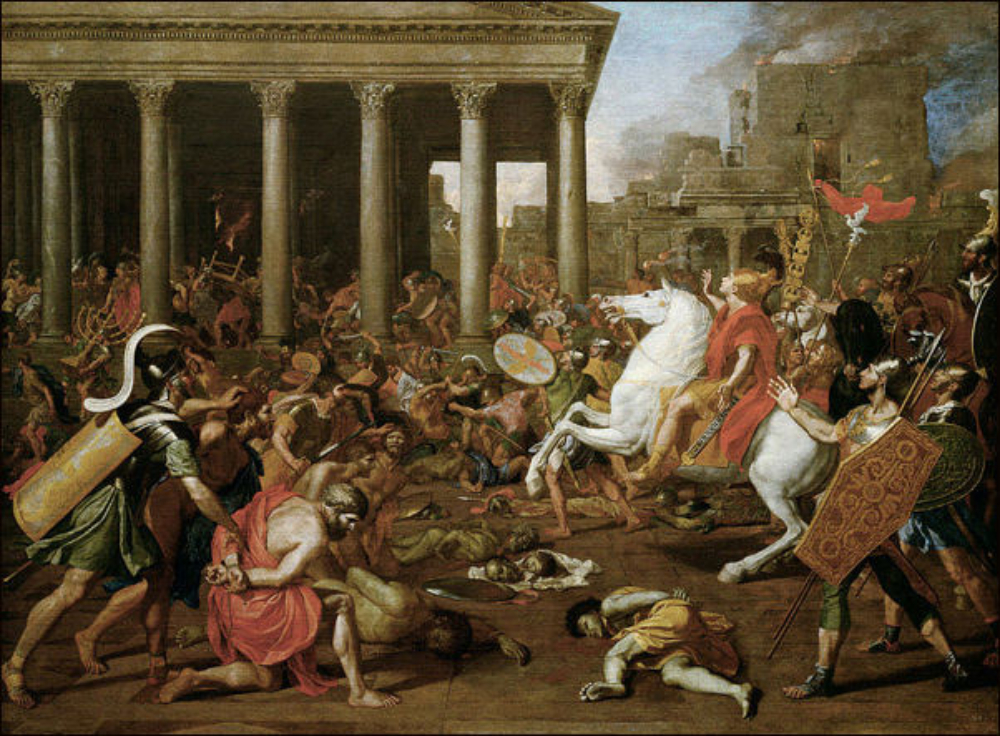
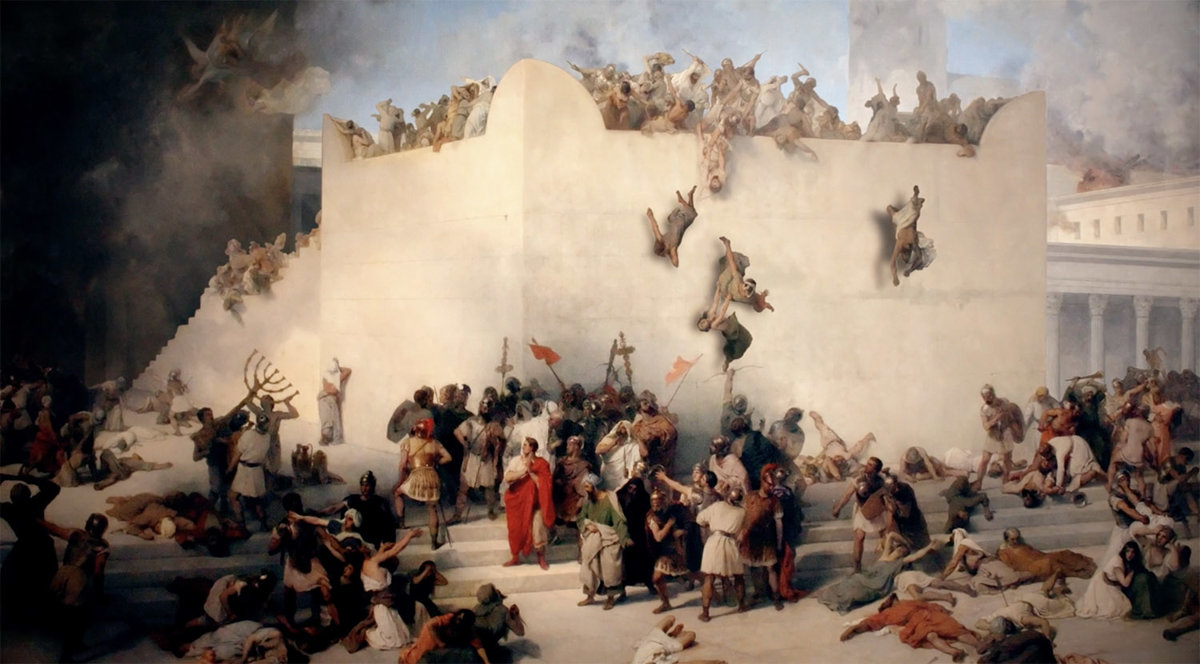 The Destruction of the Temple in Jerusalem is a historical event.During the war of AD 69-70 against the Jewish uprising, the Romans captured Jerusalem; during their attack on the Temple, which continued to resist, one of the soldiers threw a torch into its window. The fire started. The Roman chief commander Tit Flavius, later the emperor, tried to stop the fire and his outraged soldiers, who started to destroy the Temple, but it was too late. Thus in AD 70 the second Temple of Jerusalem was destroyed
The Destruction of the Temple in Jerusalem is a historical event.During the war of AD 69-70 against the Jewish uprising, the Romans captured Jerusalem; during their attack on the Temple, which continued to resist, one of the soldiers threw a torch into its window. The fire started. The Roman chief commander Tit Flavius, later the emperor, tried to stop the fire and his outraged soldiers, who started to destroy the Temple, but it was too late. Thus in AD 70 the second Temple of Jerusalem was destroyed

